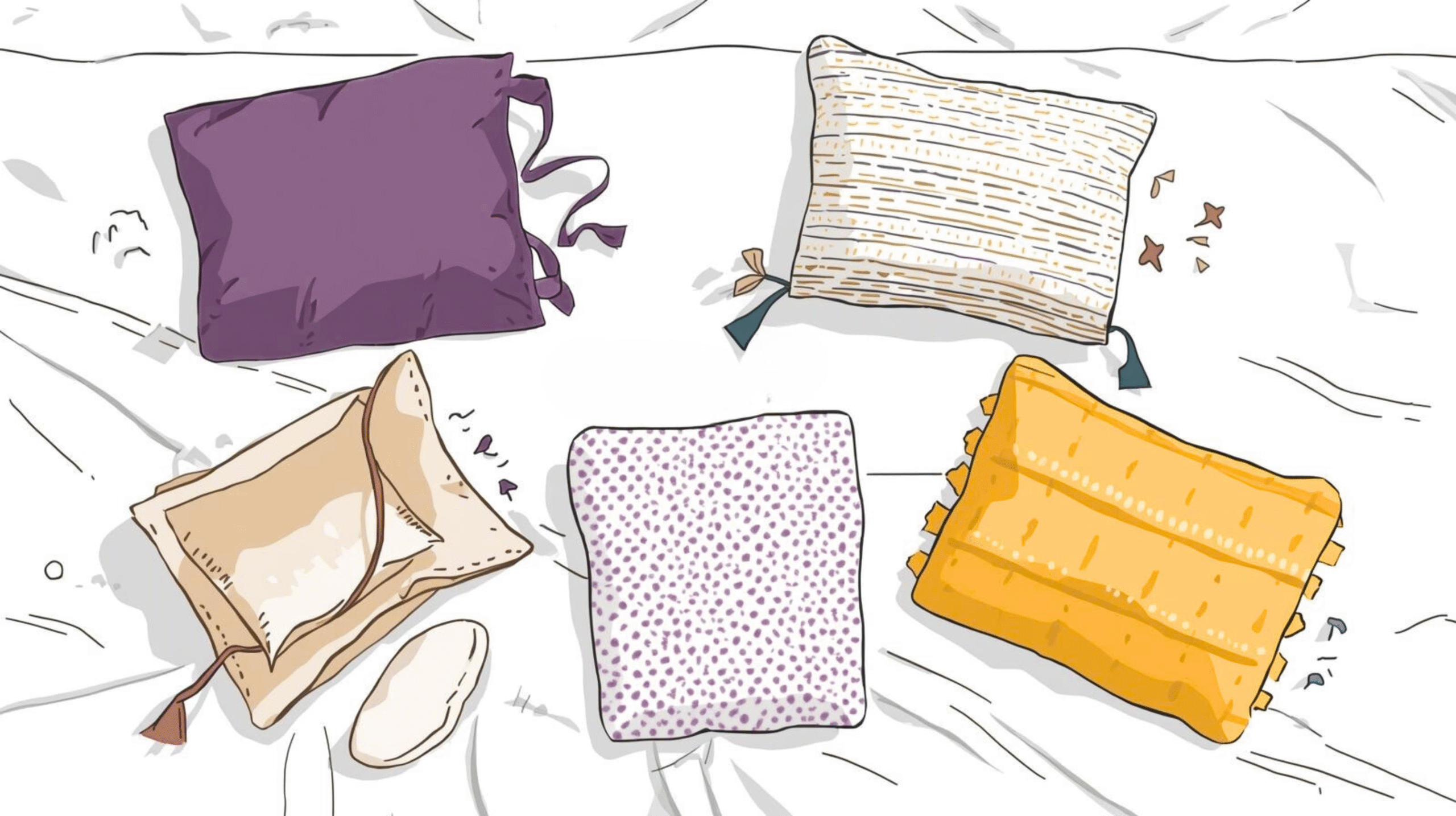When we think about a good night’s sleep, we often focus on mattresses, blankets, or even bedroom lighting. But one of the most overlooked elements in sleep health is the pillow. This simple piece of bedding cradles your head, supports your neck, and rests just inches from your nose and mouth for 6–8 hours every night. Over time, it becomes a host for dust mites, mold spores, skin cells, sweat, and allergens.
For people prone to allergies, the wrong pillow material can be a silent disruptor, causing sneezing, nasal congestion, itchy eyes, coughing, and even asthma flare-ups. For those without allergies, an unsuitable pillow material can still trap heat, cause discomfort, and lead to neck or back pain.
Choosing the right pillow isn’t only about comfort, it’s about health, hygiene, and long-term sleep quality.
How Allergies and Sleep Are Connected
Allergies can significantly impact your sleep cycle, leading to fragmented rest and reduced deep sleep. When allergens are present in your pillow, they can trigger rhinitis (nasal inflammation), which narrows the airways and forces you to breathe through your mouth. This reduces oxygen intake and can disturb the REM stage, which is crucial for mental restoration.
How Allergens Accumulate in Pillows
- Dust Mites – These microscopic organisms feed on dead skin cells and thrive in warm, humid environments like pillow fillings.
- Mold Spores – Develop when pillows retain moisture after washing or from sweat and humidity.
- Pet Dander – Tiny skin flakes from cats and dogs can settle deep in pillow fibers.
- Bacteria – Result from saliva, sweat, and natural skin oils that seep into pillow material.
Symptoms You Might Experience
- Stuffy or runny nose upon waking
- Postnasal drip or morning cough
- Itchy, watery eyes
- Increased asthma symptoms at night
- Fatigue due to interrupted sleep cycles
Breaking Down Pillow Materials and Allergy Risks
To choose the best pillow for allergies and comfort, you need to understand each material’s properties, benefits, and downsides. Let’s examine them in depth.
1. Down and Feather Pillows
- Comfort Level: Down and feather pillows are known for their plush, cloud-like feel. They conform to your head and neck, offering excellent softness and adjustability.
- Allergy Risks: These pillows can be a nightmare for allergy sufferers. Dust mites thrive in the inner pockets of down, and natural bird proteins can trigger allergic reactions in some people.
- Maintenance: They require regular washing in hot water (above 130°F / 54°C) to kill mites, followed by thorough drying to prevent mold. However, frequent washing can shorten their lifespan.
- Best For: People without allergies seek luxury comfort and are willing to maintain strict cleaning schedules.
- Expert Insight: The Asthma and Allergy Foundation of America (2022) warns that even “hypoallergenic” down pillows may still harbor allergens unless combined with dust mite-proof covers.
2. Memory Foam Pillows
- Comfort Level: Memory foam molds to the shape of your head and neck, promoting spinal alignment. It’s excellent for side and back sleepers who need firm, targeted support.
- Allergy Risks: Due to its dense structure, memory foam resists dust mites. However, chemical off-gassing (volatile organic compounds, or VOCs) can cause irritation for sensitive users.
- Maintenance: The core is not washable. Use a removable, washable cover to maintain cleanliness. Spot clean stains with mild soap.
- Best For: Those needing orthopedic support without dust mite worries, provided they choose low-VOC certified foam.
- Pro Tip: Look for CertiPUR-US® certified foam to ensure minimal emissions and safety standards.
3. Latex Pillows
- Comfort Level: Latex offers natural bounce and consistent support. It maintains shape well and doesn’t clump over time.
- Allergy Risks: Natural latex is inherently resistant to dust mites and mold, making it a good hypoallergenic choice. However, some individuals are allergic to latex proteins.
- Maintenance: Do not submerge in water. Spot clean as needed and use a washable cover.
- Best For: People who prefer natural materials and need firm, resilient support.
- Eco-Friendly Note: Natural latex is biodegradable and harvested sustainably from rubber trees.
4. Polyester Fiberfill Pillows
- Comfort Level: These synthetic pillows are lightweight, soft, and inexpensive. They come in various loft levels and are easy to replace.
- Allergy Risks: Moderate risk for allergens if not washed often. However, they can be laundered in hot water, which kills dust mites effectively.
- Maintenance: Machine washable and dryer safe, but they flatten quickly, usually within a year.
- Best For: Budget-conscious buyers or guest room use.
- Replacement Cycle: Replace every 6–12 months for hygiene and comfort.
5. Buckwheat Hull Pillows
- Comfort Level: Buckwheat hulls offer adjustable firmness and excellent airflow, keeping sleepers cool.
- Allergy Risks: Low dust mite risk due to air circulation between hulls, but moisture can cause mold if not properly cared for.
- Maintenance: Do not wash hulls. Remove them before washing the pillowcase and air hulls in sunlight periodically.
- Best For: Hot sleepers and those needing firm, moldable support.
- Drawback: They can be noisy as hulls shift when you move.
6. Bamboo and Organic Cotton Pillows
- Comfort Level: Naturally breathable and soft. Bamboo-derived rayon and organic cotton wick away moisture and stay cool.
- Allergy Risks: Minimal, as both are resistant to dust mites and bacteria. Excellent choice for sensitive skin.
- Maintenance: Covers are machine washable; filling care depends on type (memory foam, shredded foam, or fiberfill).
- Best For: Allergy-prone individuals seeking eco-friendly comfort.
- Extra Benefit: Naturally odor-resistant and antimicrobial.
What Makes a Pillow Hypoallergenic?
A pillow is labeled hypoallergenic if it is designed to minimize the accumulation of allergens and reduce the risk of allergic reactions. This includes:
- Using materials that naturally resist dust mites and mold
- Having a tightly woven, allergen-blocking cover
- Being easy to clean and maintain
Common Hypoallergenic Choices:
- Natural latex
- Bamboo-based fabrics
- Organic cotton
- High-quality memory foam
Importance of Pillow Covers and Protectors
Even the best pillow materials benefit from added protection.
Benefits of Protectors:
- Prevent allergens from penetrating the pillow core
- Extend pillow lifespan
- Make cleaning easier
What to Look For:
- Tightly woven fabric with a pore size under 10 microns
- Zipper closure for full coverage
- Machine washable
Pillow Maintenance for Allergy Prevention
Cleaning Frequency
- Memory foam & latex: Wash covers weekly; spot clean cores every 6–12 months.
- Fiberfill & down: Wash every 3–6 months in hot water.
Drying Tips
- Dry completely to prevent mold.
- Sunlight naturally disinfects and freshens pillows.
Replacement Guidelines
- Down: 2–3 years
- Fiberfill: 6–12 months
- Latex: 3–4 years
- Memory foam: 2–3 years
How Pillow Materials Affect Sleep Comfort
Firmness & Sleeping Position
- Side sleepers: Medium-firm with high loft for neck support.
- Back sleepers: Medium loft for spinal alignment.
- Stomach sleepers: Thin, soft pillow to reduce neck strain.
Temperature Regulation
- Bamboo, cotton, and buckwheat promote airflow.
- Cooling gel-infused foam can counter foam’s heat retention.
Moisture Control
- Moisture-wicking fabrics reduce bacterial growth and odor.
Natural vs Synthetic Pillow Fillings
Natural Fillings:
- Pros: Breathable, sustainable, comfortable.
- Cons: May cause allergies (down, latex) and need careful maintenance.
Synthetic Fillings:
- Pros: Affordable, washable, hypoallergenic options available.
- Cons: Can trap heat and flatten faster.
Expert Recommendations for Allergy-Friendly Sleep
- Choose hypoallergenic materials.
- Wash bedding weekly in hot water.
- Keep humidity under 50%.
- Use protective covers.
- Replace pillows as needed.
Common Myths
- Myth: All natural pillows are hypoallergenic.
Truth: Some, like down or latex, can cause allergies. - Myth: Washing once a year is enough.
Truth: Pillows need more frequent cleaning to control allergens.
Conclusion
Your pillow plays a critical role in both allergy prevention and sleep comfort. By choosing the right materials, maintaining cleanliness, and using protective covers, you can create a healthier sleep environment. The investment in the right pillow is an investment in your long-term well-being.
Frequently Asked Questions:
1. Which pillow material is best for allergy sufferers?
The best materials are bamboo, organic cotton, and natural latex. These resist dust mites, wick moisture, and reduce bacterial growth. Bamboo-derived fabrics are especially effective for hot sleepers because they regulate temperature while remaining hypoallergenic. Latex offers firm, supportive cushioning while naturally deterring mold.
2. Can memory foam pillows cause allergies?
Memory foam itself is resistant to dust mites, making it a good choice for allergy-prone individuals. However, some people experience irritation from VOCs released during off-gassing. Choosing CertiPUR-US® certified foam reduces this risk. Using a washable pillow protector ensures allergens don’t settle on the surface.
3. How often should I replace my pillow to prevent allergies?
Replace synthetic pillows every year and natural-filled pillows every 2–3 years. Over time, even hypoallergenic materials accumulate skin cells, oils, and allergens. If your pillow has lost its shape, smells, or worsens allergy symptoms, it’s time for a replacement.
4. Do pillow protectors really help with dust mite allergies?
Yes. A tightly woven, zippered pillow protector acts as a barrier against dust mites, pet dander, and pollen. They are especially beneficial for people with asthma or allergic rhinitis. Wash the protector weekly along with pillowcases for optimal results.
5. Are bamboo pillows truly hypoallergenic?
Bamboo-based fabrics are naturally hypoallergenic, antimicrobial, and moisture-wicking. They inhibit dust mites and bacteria, making them ideal for sensitive sleepers. Paired with shredded memory foam or latex filling, bamboo pillows offer both comfort and allergy protection.
References:
- American Lung Association. (2023). Dust mites and allergic reactions. Retrieved from https://www.lung.org
- Asthma and Allergy Foundation of America. (2022). Allergy bedding and dust mites. Retrieved from https://aafa.org
- CertiPUR-US®. (2023). Understanding foam certifications. Retrieved from https://certipur.us
- Environmental Protection Agency. (2021). Indoor allergens and health. Retrieved from https://www.epa.gov
- National Sleep Foundation. (2023). Choosing the right pillow for better sleep. Retrieved from https://www.sleepfoundation.org























